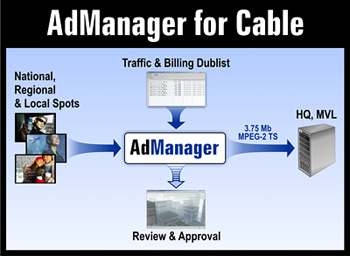High-Definition Ads Arrive Via IP
LOS ANGELES
No one knows how many television stations and cable facilities are equipped to ingest, store and play high-definition content to air. But over the last year, some facilitators of tapeless delivery noticed that their clients have been gearing up for the receipt and playback of HD commercial spots.
"Whether it's a broadcast station or a cable facility, we're getting a lot more calls," said John Pallett, product manager at Telestream, a Nevada City, Calif.-based workflow automation provider. "In a lot of places HD is actually the trigger to move to software solutions instead of tape because they need that level of operational control—the advent of HD puts more pressure on people to solve operational challenges."
Telestream's solution is FlipFactory, a family of products built around generic workflow automation and a transcoding engine. FlipFactory's Traffic Manager software is geared to broadcasters and its AdManager to cable facilities. According to Pallett, the majority of customers that are using them to automate their commercial spot workflows have purchased HD capability.

Workflow for Telestream's AdManager for Cable The company added HD functionality to Traffic Manager last year, and extended it this year to include features geared to the receipt and management of commercial spots. AdManager for Cable, which was introduced this year, following FlipFactory's 6.1 upgrade, also has these features. In addition to integrating with national spot providers and offering more control over local and regional distribution channels, the solutions manage conversion issues arising from numerous IP and HD formats, further making these products an easier alternative to home-grown software.
"They're moving to software solutions, trying to figure out how to get information out, how to link spot files to billing and traffic management, and how to automate processes while maintaining quality and reliability," Pallett said.
Included in FlipFactory 6.1's additions was On the Spot Media's EZSpot software, which automatically monitors and ingests content directly into FlipFactory from On the Spot Media's servers. According to On the Spot, more than 500 TV stations use its EZTraffic Online Traffic Management System, which accommodates various formats.
"We're prepared for the HD flow," said Doran Levi, chief technologist at On the Spot. "Some stations are already asking us to send HD files to them."
THE TRANSMISSION SIDE
Another Telestream client launched a major initiative this year to better handle an anticipated boost in HD spot traffic.
"More and more advertisers are finishing their commercials in HD," said Karen Dealy, senior vice president of affiliate relations for DG FastChannel, a Dallas–based provider of digital transmission services. The company reported that its distribution network is used by more than 5,000 advertisers and agencies, and more than 21,000 online radio, television, cable, network and print publishing destinations.
At press time, Dealy estimated that about 3 to 4 percent of the total volume of commercial spots that DG FastChannel transmitted was in an HD format. She said her company anticipated significant growth during the next 12 to 18 months, based upon ads broadcast during the Olympics coverage and upcoming interest in the NFL and new prime time season.
DG FastChannel announced it was spending $4 million on a new, more robust hardware platform (HD Xtreme edge servers) this year, with another $4 million slated for building a redundant HD network operations center in Atlanta. The third part of this three-pronged approach to boost capacity for its IP multicast over satellite and terrestrial IP delivery was the implementation of new acceleration technologies. IP multicast, which delivers the bulk of the traffic, facilitates transmission of one spot for many destinations; terrestrial IP delivery facilitates smaller orders, tighter (one-hour) deadlines and retransmission.
"The choke point is the bandwidth into the station," said Tammie Childs, senior vice president of engineering at Pathfire. "To overcome that, you increase the bandwidth and accelerate the connection."
Increased bandwidth from high speed data connections to the stations overcome the former, while accelerators reduce the amount of data and increase the efficiency of the protocol for delivering it. David Unsworth, senior vice president of technical operations at Pathfire, said that IP multicast delivery would benefit from DVB-S2 (second generation digital video broadcasting satellite protocol). At press time, DG FastChannel was testing products from various LAN acceleration software providers with the intention of embedding one of them in its platform to increase the efficiency of terrestrial IP delivery.
In addition, dedicated broadband connections were provided to large volume sites, format conversions were optimized and traffic management systems have been installed. According to Dealy, the company has also worked with third-party venders on interfacing its Spot Box product to support automated HD file transfers from players such as Crispin, Grass Valley, Masstech, Pro-Bel, Rhozet and Telestream.
TOO EARLY FOR SOME?
Other providers are not as convinced about imminent demand for automated delivery of HD spots.
According to Jim Daly, chief information officer at the ITN network, HD spots have "not been an issue with our national advertisers," and the broadcasters' main near-term agenda is ensuring a seamless transition to a digital plant.
"Right now stations' traffic and billing systems are not in a position to cut local HD ads into their HD broadcast—so they only need one traffic system," he said. "When [stations] are able to traffic in HD commercials, then we will look at how to deliver the HD versions of the commercials."
Get the TV Tech Newsletter
The professional video industry's #1 source for news, trends and product and tech information. Sign up below.
